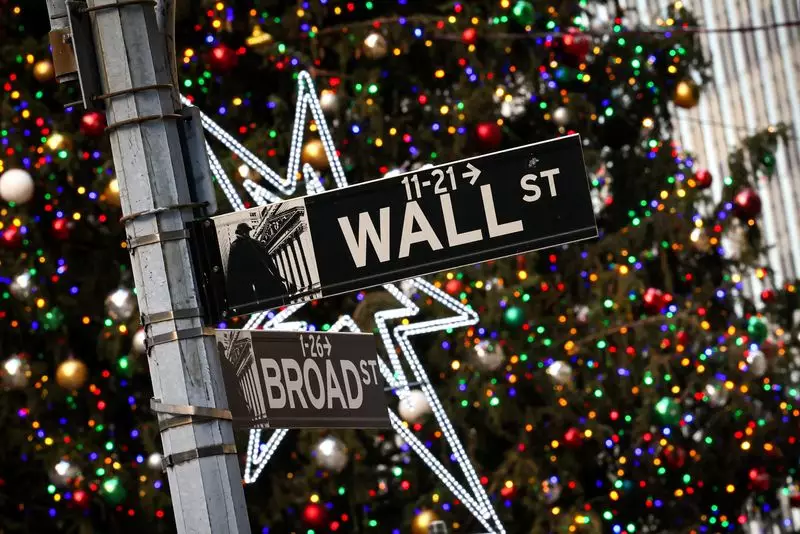In the lead-up to the holiday season, Wall Street displayed a notable resilience characterized by incremental gains in major stock benchmarks. The surge was primarily fueled by the performance of megacap stocks—those companies with a market capitalization exceeding $200 billion—which play a pivotal role in influencing overall market sentiment. As trading volumes experienced a natural decline due to holiday-induced investor inactivity, the systemic impact of these stocks on indices became more pronounced.
On this particular trading day, a harmonious blend of optimism and market dynamics saw the so-called “Magnificent Seven,” a term often used to describe leading tech giants, all show gains, with Tesla leading the charge with an impressive 5.1% increase. This uplift placed significant upward pressure on the Consumer Discretionary sector, which itself climbed 1.9%, reinforcing the idea that these high-profile stocks are instrumental in steering market direction during quieter trading periods.
Sector Performance and Investor Sentiment
The positive sentiment was not confined to Tesla alone; other sectors, notably technology, also experienced positive shifts. Chip manufacturers — specifically Broadcom and Nvidia — reported gains of 3% and 1.1% respectively. This steady performance reflects not only a recovery from prior setbacks but also demonstrates investor confidence in these companies as fundamental components of the burgeoning tech landscape. Arm Holdings also saw its shares rally by nearly 4%, recovering after a challenging litigation setback that had previously weighed down its stock price.
While trading was truncated ahead of Christmas, with a market close planned for 1:00 p.m. ET and a closure for the following day, the anticipation surrounding market performance remained palpable. The S&P 500, for example, recorded a gain of 0.70% during this session, while the Nasdaq Composite exhibited a more robust 1.00% uptick. The Dow Jones Industrial Average, although more modest in its climb, still posted a respectable gain, shedding light on broad-based market strength despite looming concerns about macroeconomic stability.
The market’s movement can be linked to several economic indicators influencing investment decisions. Sam Stovall, CFRA Research’s chief investment strategist, remarked on investors’ relief following a previous hawkish outlook that seemed to suggest a return of inflationary pressures. The recent softer reading on the Personal Consumption Expenditures (PCE) index offered a glimmer of hope, leading to speculation that inflation might not rear its head as significantly as previously feared. This realization beckoned the idea that market trends could persistently creep higher as the year draws to a close.
However, it is essential to note that this optimism is juxtaposed against a backdrop of rising expectations regarding interest rates. Following the U.S. Federal Reserve’s recent decision to lower borrowing costs for the third time this year, policymakers provided guidance anticipating only two additional reductions in the following year—fewer than earlier forecasts had suggested. Such developments point toward a careful balance the Fed must strike between fostering economic growth and curbing potential inflation stemming from policy changes under the incoming administration.
Historical trends indicate that this period coincides with a phenomenon known as the “Santa Claus rally,” wherein the S&P 500 has historically gained an average of 1.3% during the final days of December and into early January. This tendency underscores a seasonally driven optimism that can elevate stock prices even amidst broader economic uncertainties. Yet, amidst this pattern of holiday-induced cheer, a note of caution persists; many investors are beginning to question the sustainability of these gains in light of sky-high valuations and the overall health of the equity markets.
As unique developments unfold, such as NeueHealth’s staggering 69% surge after announcing plans for a $1.3 billion privatization deal, it becomes evident that a mixed bag of earnings reports and corporate news continues to influence investor sentiment. On a contrasting note, American Airlines faced challenges revealing the underlying vulnerabilities that exist even within seemingly sturdy sectors.
While Wall Street demonstrates resilience and positive momentum, particularly through the lens of major growth stocks and economic indicators, the coming weeks will demand scrutiny as investors navigate potential headwinds associated with valuations and interest rate expectations. The outlook remains dynamic and uncertain, highlighting the intricate interplay of market forces as we enter the new year.

